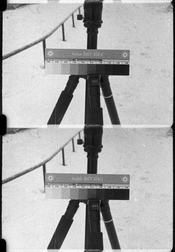@koraks, I have been seeing this a lot with my 120 film. Would you care to comment if you think this kind of pale edges (as seen on the positive) is more likely due to over agitation or under agitation?
120 is tricky. It's hard to tell whether it's
over or
underagitation that does it. Sometimes, there are clear surge marks in specific spots on the film; in that case, you could argue it's localized overagitation. But the key issue is that agitation is apparently different across the surface of the film. The geometry of the reels does a lot in this regard, as it makes the flow of the developer more turbulent in that zone, which means that the exchange of fresh and spent developer (to put it very simply) happens quicker in that zone. The issue is rendered more complex by the fact that differences at the start of the process may even out later on, except that the head-start that e.g. the edges get in the first 30 seconds or so, will remain visible as density keeps building on top of other density.
Taken together, the usual advice to resolve this consists of two parts, which can be applied in tandem or separately (try what works best for you):
* Ensure sufficiently turbulent agitation. Don't be too gentle when doing twists & turns with the tank.
* Introduce a prewet. Ensuring that the entire film is already water-soaked before the developer is introduced to it, can prevent the issue of unevenness that arises at the start of the development process.
Going back to
@Freddenacka's film - the unevenness problem seems to have resolved itself in his case, at least in the more recent frames posted.
I might be wrong but I think this is best for iso 200.
I really couldn't say. Here's the first image you posted together with the 10-minute example (top frame):
What's better in the 10-minute frame is that the hot edges are gone. So that's good.
What I did with the 7-minute frame is simply adjust contrast to match the 10-minute frame. There are some subtle differences in rendering. Overall, the result is pretty similar.
What I hope to have shown above is that trying to figure out the best development time while ignoring what happens in the scanning and digital contrast adjustment part of the process isn't a particularly useful endeavor.












